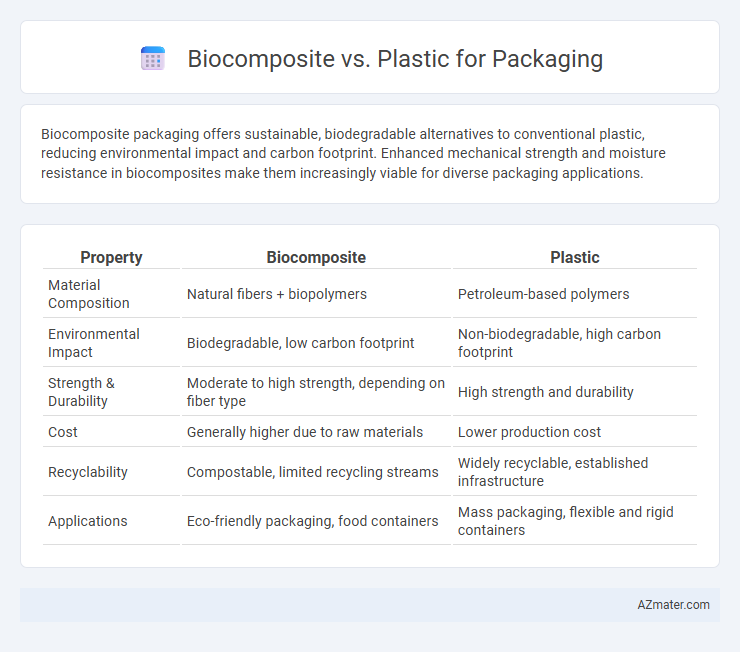Biocomposite packaging offers sustainable, biodegradable alternatives to conventional plastic, reducing environmental impact and carbon footprint. Enhanced mechanical strength and moisture resistance in biocomposites make them increasingly viable for diverse packaging applications.
Table of Comparison
| Property | Biocomposite | Plastic |
|---|---|---|
| Material Composition | Natural fibers + biopolymers | Petroleum-based polymers |
| Environmental Impact | Biodegradable, low carbon footprint | Non-biodegradable, high carbon footprint |
| Strength & Durability | Moderate to high strength, depending on fiber type | High strength and durability |
| Cost | Generally higher due to raw materials | Lower production cost |
| Recyclability | Compostable, limited recycling streams | Widely recyclable, established infrastructure |
| Applications | Eco-friendly packaging, food containers | Mass packaging, flexible and rigid containers |
Introduction to Sustainable Packaging Materials
Biocomposite packaging materials combine natural fibers such as cellulose or hemp with biodegradable polymers, offering a sustainable alternative to conventional plastics derived from fossil fuels. These materials reduce carbon footprint and enhance compostability, making them ideal for eco-friendly packaging solutions. Plastics, while durable and versatile, contribute significantly to environmental pollution due to their slow degradation and reliance on non-renewable resources.
Defining Biocomposites and Plastics
Biocomposites are sustainable materials composed of natural fibers combined with biodegradable polymers, offering an eco-friendly alternative to traditional plastics in packaging. Plastics are synthetic polymers derived primarily from petrochemicals, characterized by durability and high versatility but associated with significant environmental pollution. The key difference lies in biocomposites' biodegradability and renewable sourcing, contrasting with plastics' persistence and fossil fuel dependence.
Material Composition and Sources
Biocomposite packaging is primarily composed of natural fibers such as cellulose, starch, or lignin combined with biodegradable polymers derived from renewable resources like corn starch or sugarcane. In contrast, plastic packaging mainly consists of synthetic polymers such as polyethylene, polypropylene, or polystyrene produced from petrochemical sources. The renewable origin and biodegradable potential of biocomposites contribute to reduced environmental impact compared to the non-biodegradable, fossil fuel-based composition of conventional plastics.
Environmental Impact: Biocomposite vs Plastic
Biocomposites, derived from renewable natural fibers and biodegradable polymers, significantly reduce carbon emissions and landfill waste compared to conventional plastics made from fossil fuels. Unlike plastics, biocomposites biodegrade under proper composting conditions, minimizing microplastic pollution and promoting soil health. Lifecycle assessments reveal that biocomposite packaging offers a lower environmental footprint by conserving non-renewable resources and enhancing end-of-life sustainability.
Performance and Durability Comparison
Biocomposite packaging materials exhibit superior biodegradability and reduced environmental impact compared to conventional plastics, making them a sustainable alternative. While plastics often provide higher resistance to moisture, chemicals, and mechanical stress, biocomposites can be engineered to achieve comparable tensile strength and flexibility through fiber reinforcement. Performance tests indicate that durability varies widely among biocomposites based on composition, but recent advancements have significantly closed the gap with plastic packaging for many commercial applications.
Cost Analysis and Economic Viability
Biocomposite packaging materials often have higher initial production costs compared to conventional plastics due to raw material expenses and manufacturing complexities. However, long-term economic viability improves through reduced environmental compliance costs and growing consumer demand for sustainable products. Market trends indicate biocomposites may achieve cost parity as production scales and bio-based feedstock availability increases.
Biodegradability and End-of-Life Options
Biocomposites offer superior biodegradability compared to traditional plastics, breaking down naturally within months under industrial composting conditions, while plastics can take centuries to decompose. End-of-life options for biocomposites include composting and anaerobic digestion, reducing landfill reliance and environmental impact. Conventional plastics primarily rely on recycling and incineration, which often contribute to pollution and greenhouse gas emissions.
Regulatory Standards for Packaging Materials
Biocomposite packaging materials often comply with strict regulatory standards such as ASTM D6866 for biobased content and EN 13432 for compostability, ensuring environmental safety and biodegradability. Plastic packaging is regulated under guidelines like the FDA's 21 CFR for food contact materials and the EU's Regulation (EC) No 1935/2004, focusing on chemical migration limits and human health safety. Compliance with these standards guarantees that both biocomposites and plastics meet legal requirements for packaging safety, sustainability, and consumer protection.
Innovations and Market Trends
Biocomposite packaging innovation leverages natural fibers combined with biodegradable polymers, enhancing mechanical strength and reducing environmental impact compared to traditional plastics. Market trends show escalating demand for sustainable packaging solutions, driven by consumer awareness and regulatory pressures, fueling investments in scalable biocomposite production technologies. Advances in material science enable tailored biocomposites with improved barrier properties and cost-effective manufacturing, positioning them as a competitive alternative to conventional plastic packaging.
Future Prospects in Packaging Solutions
Biocomposites offer sustainable alternatives to conventional plastics in packaging by utilizing renewable materials like plant fibers and biodegradable resins, reducing environmental impact and enhancing compostability. Advances in biocomposite technology promise improved strength, barrier properties, and cost-effectiveness, making them viable for diverse packaging applications. Future prospects emphasize the integration of bio-based materials within circular economies, encouraging innovation for scalable, eco-friendly packaging solutions that align with global sustainability goals.

Infographic: Biocomposite vs Plastic for Packaging
 azmater.com
azmater.com